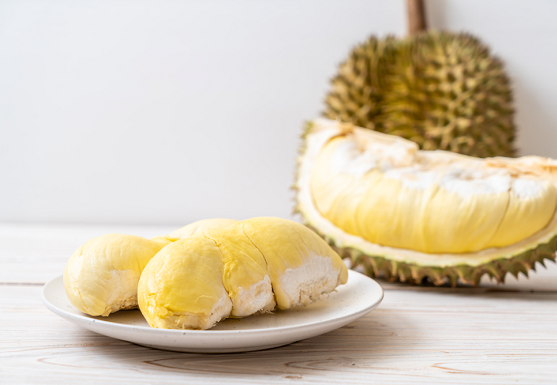
It is the durian season again! Nicknamed “King of Fruits”, this creamy, seasonal tropical fruit with a spiky exterior is grown in Southeast Asian countries and is known for its strong and distinctive smell.
Durian season occurs between the months of June and September, with a “minor season” from December to February. During this time, durian prices drop significantly as supply increases – providing durian-lovers more opportunities to indulge in fresh, great-tasting durians.
One whole durian contains about 900-1500 calories depending on its size. The average 1kg durian contains 1350 calories which is nearly a person’s entire calorie limit for a day! One small seed (about 40-50g of seed and flesh) contains about 56 calories and 1.4g of fat. A large seed (80g) has around double that, with 113 calories and 2.8g fat, compared to an apple (150g) which is about 79 calories and less than 1g fat.
For large durian feasts, the calories and fat can really add up. For instance, having 3 durians in 1 sitting can equal over 4000 calories! This is the equivalent of eating over five plates of char kway teow at 1 time, which is almost unheard of. Yet, it is common to hear durian-lovers wolf down more than 1 whole durian at a time.
Enjoying durians in moderation is a good goal to aim for while keeping an eye on your weight and overall health. Eating 2 to 3 seeds of durian a day is sufficient.
HEALTH BENEFITS
Durians contain heart-healthy monounsaturated fats (which help to lower bad LDL cholesterol), vitamins and minerals such as Vitamin C, potassium, magnesium and iron and have a high fibre content (about 3g in a large 80g seed).
Durians are also rich in polyphenols such as flavonoids and carotenoids – compounds which have antioxidant properties and may decrease the risk of chronic diseases such as cardiovascular diseases, cancer and diabetes if taken as part of a healthy diet.
Despite packing a nutritional punch, durians are energy-dense and can lead to weight gain if eaten frequently and in large amounts. People with diabetes should be mindful that larger seeds contain higher amounts of carbohydrate thus can increase blood sugar levels.
With so many durian types out there, what’s the difference between them? Let’s have a look:
| Mao Shan Wang (MSW) | Old Tree Mao Shan Wang | XO Durians | D24 Durians | Black Thorn or Black Pear | Red Prawn | |
|---|---|---|---|---|---|---|
| Taste & Texture | Has a bittersweet, rich and creamy taste. | A richer flavour which is slightly more bitter than typical MSW durians. | Has a slightly alcoholic aftertaste.
Seeds have a softer flesh with a higher water content and is thus more runny. |
Very creamy and slightly bitter. | Smooth, creamy texture and a slight bitterness | Their intense, sweet taste and somewhat of a milky aftertaste make them another popular choice in Singapore. |
| Size of Seeds | Relatively small seeds. | Relatively small seeds. | Seeds vary from small to large sizes. | Rounder seeds with a pale yellow colour. | Small seeds with a pale greyish colour | Larger seeds which are orangey-red. |
| One of the most popular durians in Singapore. | These premium durians which are plucked from slightly older trees can cost nearly double the price of typical MSW durians and around 3 times the price of Red Prawn durians. |
REFERENCES
USDA National Nutrient Database
Malaysian Food Composition Database
Health Promotion Board – Energy & Nutrient Composition of Food
Cheong T. (n.d.) Durians: 8 Myths and Facts About the King of Fruits. Healthxchange.sg (Singhealth, Changi General Hospital). https://www.healthxchange.sg/food-nutrition/food-tips/durian-myths-facts-king-fruits Accessed 5 June 2019.
Cheong T. (n.d.) Durian Myths: The Truth About Durian and Alcohol, Cholesterol & more. Healthxchange.sg (Singhealth, Changi General Hospital). https://www.healthxchange.sg/food-nutrition/food-tips/durian-myths-alcohol-cholesterol Accessed 13 June 2019.
A Aziz, N. A., & Mhd Jalil, A. M. (2019). Bioactive Compounds, Nutritional Value, and Potential Health Benefits of Indigenous Durian (Durio Zibethinus Murr.): A Review. Foods (Basel, Switzerland), 8(3), 96. doi:10.3390/foods8030096
This article is contributed by our dietitians from the Nutrition and Dietitian department of Mount Alvernia Hospital.
To learn more about our Nutrition and Dietitian services, click here